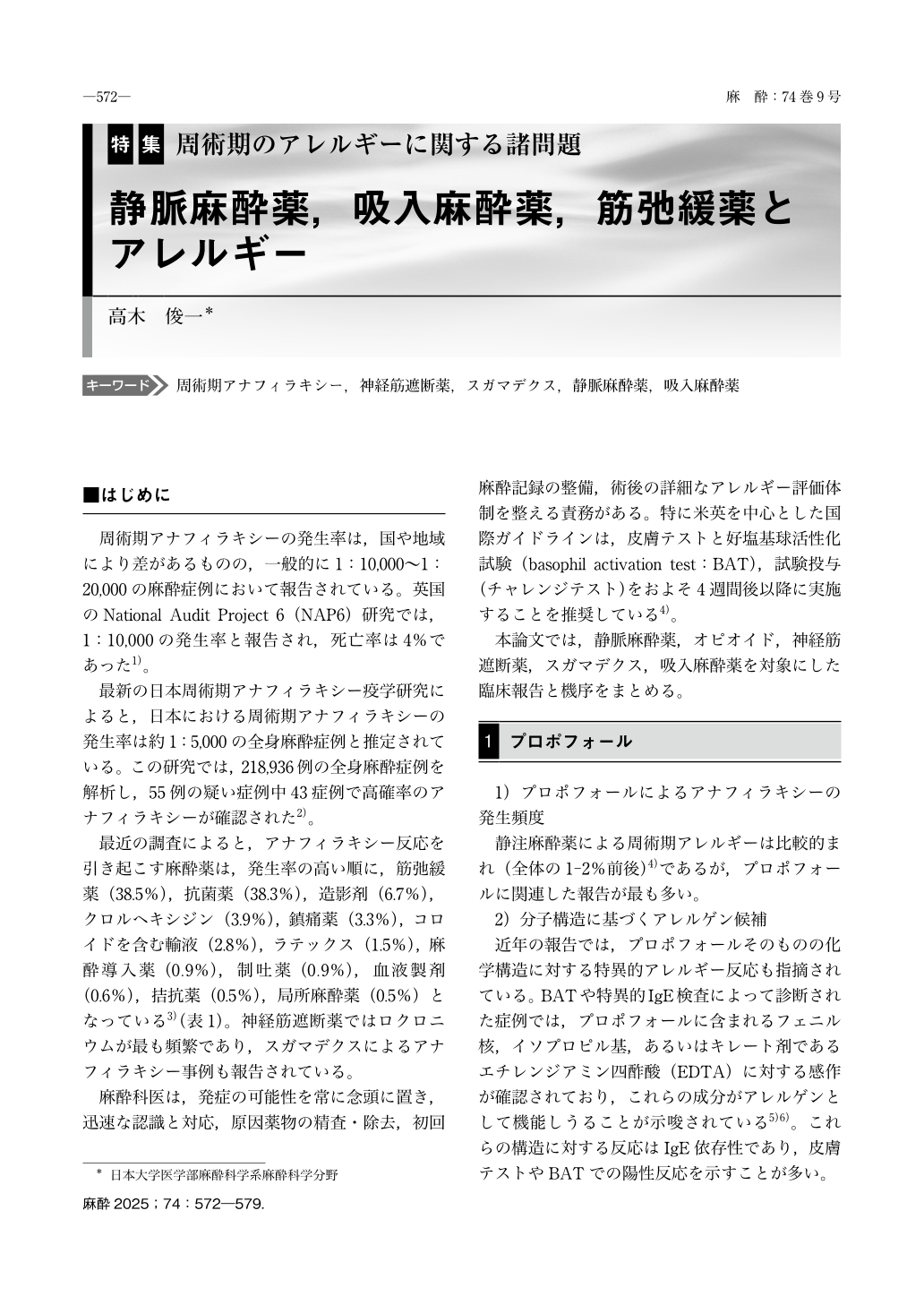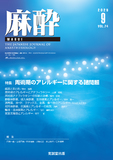Japanese
English
- 有料閲覧
- Abstract 文献概要
- 1ページ目 Look Inside
- 参考文献 Reference
はじめに
周術期アナフィラキシーの発生率は,国や地域により差があるものの,一般的に1:10,000~1:20,000の麻酔症例において報告されている。英国のNational Audit Project 6(NAP6)研究では,1:10,000の発生率と報告され,死亡率は4%であった1)。
最新の日本周術期アナフィラキシー疫学研究によると,日本における周術期アナフィラキシーの発生率は約1:5,000の全身麻酔症例と推定されている。この研究では,218,936例の全身麻酔症例を解析し,55例の疑い症例中43症例で高確率のアナフィラキシーが確認された2)。
最近の調査によると,アナフィラキシー反応を引き起こす麻酔薬は,発生率の高い順に,筋弛緩薬(38.5%),抗菌薬(38.3%),造影剤(6.7%),クロルヘキシジン(3.9%),鎮痛薬(3.3%),コロイドを含む輸液(2.8%),ラテックス(1.5%),麻酔導入薬(0.9%),制吐薬(0.9%),血液製剤(0.6%),拮抗薬(0.5%),局所麻酔薬(0.5%)となっている3)(表1)。神経筋遮断薬ではロクロニウムが最も頻繁であり,スガマデクスによるアナフィラキシー事例も報告されている。
麻酔科医は,発症の可能性を常に念頭に置き,迅速な認識と対応,原因薬物の精査・除去,初回麻酔記録の整備,術後の詳細なアレルギー評価体制を整える責務がある。特に米英を中心とした国際ガイドラインは,皮膚テストと好塩基球活性化試験(basophil activation test:BAT),試験投与(チャレンジテスト)をおよそ4週間後以降に実施することを推奨している4)。
本論文では,静脈麻酔薬,オピオイド,神経筋遮断薬,スガマデクス,吸入麻酔薬を対象にした臨床報告と機序をまとめる。
Perioperative anaphylaxis is a rare but potentially fatal event that requires immediate recognition and intervention. This review summarizes the incidence, mechanisms, and diagnostic considerations of anaphylaxis related to commonly used anesthetic agents, presented in the order of propofol, opioids, neuromuscular blocking agents(NMBAs), sugammadex, and volatile anesthetics.
Propofol is the most frequently implicated intravenous anesthetic in perioperative allergic reactions, accounting for approximately 1-2% of cases. Immunoglobulin E(IgE)-mediated hypersensitivity has been associated with the isopropyl groups, phenol ring, and additives such as ethylenediaminetetraacetic acid(EDTA). Despite earlier concerns, large-scale studies have demonstrated no significant increase in risk in patients with egg or soy allergies. Basophil activation tests(BATs)and specific IgE assays can be used to identify sensitization to propofol’s core structures.
Opioids are infrequent causes of perioperative anaphylaxis, comprising only 1.3% of cases. Most reactions are non-IgE-mediated and result from direct mast cell activation via MRGPRX2, particularly with morphine and codeine. Fentanyl and remifentanil have a lower tendency for histamine release. Although rare, IgE-mediated reactions to fentanyl and tramadol have been confirmed by skin testing in some cases.
NMBAs are the leading cause of anaphylaxis in many countries, accounting for over 60% of cases in France and 16.7% of cases in Japan. Rocuronium and succinylcholine are most commonly implicated. A shared structural feature―quaternary ammonium―is a known IgE epitope that underlies high cross-reactivity among NMBAs. Environmental exposure to similar molecules in cosmetics or cough suppressants(e.g., pholcodine)may promote sensitization. Diagnostic evaluation includes skin testing and BAT.
Sugammadex, a modified γ-cyclodextrin used to reverse aminosteroid NMBAs, has been associated with rare anaphylactic reactions, especially in Asian populations. Immediate reactions confirmed by BAT or skin tests suggest an IgE-dependent mechanism. Additionally, sugammadex has been reported to mitigate rocuronium-induced anaphylaxis in some cases by encapsulating the offending agent, although its therapeutic role remains adjunctive rather than primary.
Volatile anesthetics such as sevoflurane and isoflurane are exceedingly rare causes of anaphylaxis. Sevoflurane-induced reactions have been confirmed via skin tests and BAT, suggesting IgE-mediated hypersensitivity. The underlying mechanisms may involve haptenization or metabolism-related antigen formation, but data remain limited.
In conclusion, understanding the allergenic potential and immunologic pathways of anesthetic agents is essential for safe perioperative management. Individualized preoperative evaluation is crucial in patients with a history of drug hypersensitivity.

Copyright © 2025 KOKUSEIDO CO., LTD. All Rights Reserved.


